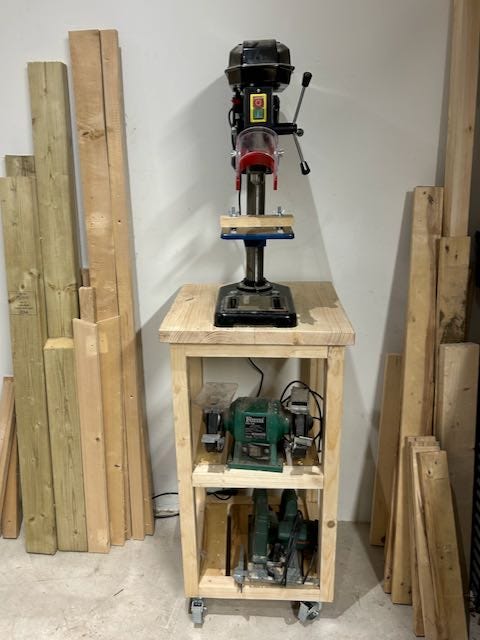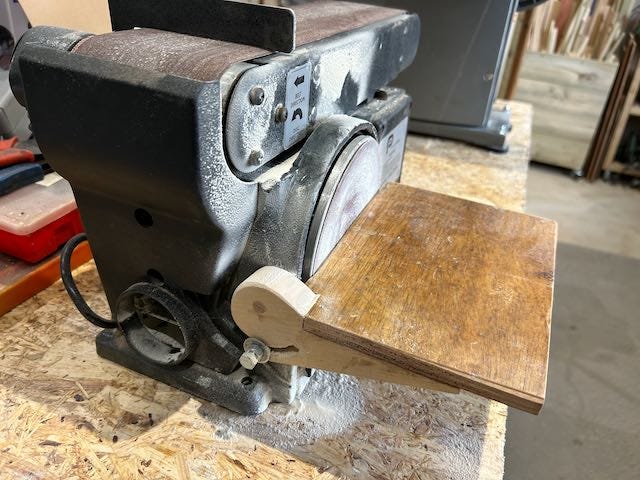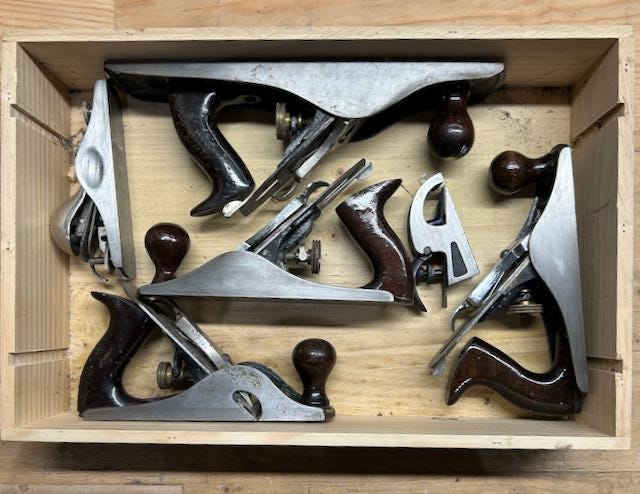Hand tools rule my heart, but power tools give me wings
After two years on the slow journey from hacker to craftsmen I'm moving up a gear
My journey from hacker to craftsman began in December 2022 . My goal is to achieve mastery (but I’ll accept basic competency for now) in creating practical and joyful objects in wood using hand tools.
I’ve now figured out that most furniture-sized things can be built to a high standard with only seven different types of tools. A saw, a plane, a chisel, a pencil (or marking knife), a drill, a steel rule and a try-square. A workbench helps.
But I’ve also discovered that acquiring the skills to set up or properly use even the simplest of these tools takes time. So I’ve been studying hard. Watching more YouTube videos than I should (too many fascinating distractions). I would like to have read more, but I’ve learnt a lot. I’ve been buying more hand tools, mostly on Ebay, some of which I actually needed.
I’ve concentrated on mastering three key foundational areas: sharpening tools, accurate measurement and cutting straight. And I’m slowly rewiring my brain to win the mental battle too. Plan ahead, move slowly, take frequent breaks.
The days before power
The first dozen or so projects I completed were all done almost entirely with hand tools. The only exception was an electric drill. Even Paul Sellers uses one of those.
I’ve got better at sharpening, measuring and cutting straight and my pleasure from working with wood grows the better I get. My chisels pare and slice through wood with ease. My vintage Disston tenon saw, from the Bristol Design Tool Shop has been cleaned, sharpened on my Rex Krueger designed saw vice and cuts straight lines with a narrow kerf. My dovetails are starting to be something I can be proud of.
Paul, Rex, Matt Estlea, Rob Cosman and others have been my YouTube handtool heroes. I’m a hobbyist woodworker and not a professional. The decision to use hand tools was a conscious choice. I do it for the process as much as the product. I gain the most pleasure when I remember to put the brakes on and slow down my natural tempo. And the outcome is better too.
The woodworking video world is dominated by the power tool brigade. I have to confess. I’ve been watching a few of those too.
To this gentle, novice, middle-aged hand tool woodworker power tools have seemed noisy, dusty and potentially dangerous. When mishandled they will destroy a piece of wood in seconds. And fingers. Power tools require more space than hand tools. They are usually expensive. Strange-looking Personal Protective Equipment is required.
A new shopping experience
But then earlier this summer I started buying power tools.
So what happened?
Having begun to master the basic woodworking hand tool skills I’ve now allowed myself to listen to the voice in my head that has been telling me for a while that some things really do not make sense to do by hand. Even for a hand-tool woodworker.
Woodwork is not meant to be a competitive sport. If we are not professionals then woodworking is our hobby. We are allowed to define our own rules to maximise our pleasure and no one’s to say these rules can’t change over time. Each woodworker will have their own personal guidelines for when power tools are an acceptable alternative to the hand saw or traditional plane. What feels right one day may feel like cheating the next. Its a personal thing, no one else cares.
Over the last few months, as I’ve crossed the line from being a pure hand tool woodworker and begun using some power tools I found I don’t feel guilty for taking shortcuts. Instead I have dramatically improved the pleasure I get from working with wood. I’ve cut out, (literally), the boring bits, leaving more time for the creative work. I’ve opened up more areas in which to develop new skills and fresh problems to solve.
Cheap and makes chips
It turns out I was wrong about the cost too. All of my power tools were cheap. A couple cost more than £100 but not a lot more. Some are second-hand. Others were bought new. One is not quite complete. Most of them needed to be tuned and upgraded. One has already broken. But for the most part I’m thrilled with my purchases.
Let me introduce you to my new partners in power…
A band saw. How did I live without a band saw for so long? Rip-cutting lengths of wood down to size is hard work with a handsaw. It takes a long time and doesn’t give much pleasure. So when I came across Jack Sumeray's review of the Titan TTB705BDS bandsaw on YouTube in July I bought it minutes later for £150 from Screwfix in the UK. As advised, I upgraded to new blades. I haven’t looked back.
A pillar drill. Usually more reliable than a hand drill for creating consistent, straight holes. I love the slight tremor as the drill bites into the wood and the scent of heated wood shavings. I went too cheap with the drill press from Lidl though. Only £100 but it’s underpowered, the drill chuck jaws are 3mm out from true and bits of plastic are snapping off. I’ve my eye on a much better vintage drill at about the same price for sale nearby. The stand, though, is all my own work.
An electric planer. I keep acquiring free timber. Reclaimed, waste and even driftwood. An electric planer quickly cleans up the wood and helps make it workable. No point going for a budget brand when I could get the Bosch version for around £50. Thanks to the video from DIYforKnuckleheads I’m now making smoother cuts too.
A hand-held electric saw. I can’t avoid doing the occasional house project. A hand-held electric saw is the only realistic way to cut Plywood, OSB and MDF sheets. My current one is 20 years old and until recently I’ve been struggling to set up guides accurately. I’ve followed Jack Sumery’s advice again and bought the Evolution saw track.
Disc and belt sander combination. I’ve learnt how to achieve square edges on the end of wood through better sawing and mastering a plane and shooting board. Curved ends can be achieved with a rasp and coping saw. But a disc and belt sander combination is so much quicker and more accurate for both these jobs. I bought an old Performance Powertools sander at an online auction for £40. It works well but was missing one vital part. Fortunately I now had a band saw to create a new adjustable sanding bed.
Henry Hoover. Of course, now I have dust to remove. Henry was replaced in the house by a Dyson a few years ago and now lives with me in my workshop. Fine for now but I will need a more robust dust collection system if any more power tools arrive.
It’s not cheating if…
So now I am a convert to power tools for some tasks.
I’ve identified two broadly consistent themes emerging where I will use them without feeling that I am compromising my hand tool craftsman credentials.
The first is that power tools are the best choice when they help speed up getting the wood close to the dimensions that I need for the finished item. Finishing off with my Stanley No.5 plane is still needed to achieve an accurate, smooth and silky finish.
The second is that if it is possible to achieve a level of accuracy in a cut or finish that would be impossible, very hard, or very laborious to do by hand then a power tool is acceptable.
And I may be using more power tools in the future.
Today all my projects are one-off and I usually don’t have a fixed timeline to finish them.
Creating the first version of an object is an exercise in discovery and problem-solving, a chance to push my skills in marking out and cutting strong joints such as mortice and tenon. But once I have figured out the design of a piece of furniture, say a bedside table, successfully built it and then decided to build another my approach and how I consider the task changes. Now I am faced with a new challenge. How do I build the future, repeated versions faster but without compromising on the visual quality and strength? Maybe I don’t want to make hand cut joints for this one. Maybe someone will pay me to build that bedside table. In the future that may well be a third motivation for more extensive use of power tools.
But I am not there yet. My power tools may give me wings, but my planes are still where my heart is. And I don’t need to get dressed up to use them.








absolutely love this! Next stop - the Repair Shop !
There's nowt wrong with power tools, but of course hand tools are pleasanter -- it just depends how busy you are :-)
You might find this old post of mine interesting:
https://walteregon.substack.com/p/cutting-tenons-pt1
Cheers!